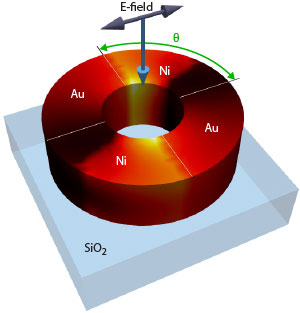| Posted: Oct 21, 2015 |
Doubling up improves nanoring design
(Nanowerk News) A bimetallic nanoring that generates a short magnetic pulse when irradiated by a laser pulse has been theoretically studied by A*STAR researchers. It shows exciting potential for investigating magnetic switching and realizing rapid data storage ("Novel layout of a bi-metallic nanoring for magnetic field pulse generation from light").
|
 |
| When a light pulse (black arrow indicates its electric field and blue arrow shows propagation direction) is irradiated on a nanoring made of nickel and gold on silica substrate (blue), the nanoring generates a magnetic pulse via the thermoelectric effect.
|
| Unlike their electrical and optical equivalents, ultrashort magnetic pulses have proved very difficult to generate. These pulses are needed to explore magnetic switching in materials — a process that underpins virtually all of today’s data storage technology. However, most methods for generating magnetic pulses use large-scale particle accelerators or are limited to specific materials and do not produce tightly confined magnetic fields.
|
|
Now, Guillaume Vienne and colleagues at the A*STAR Data Storage Institute have theoretically proposed a nanoring that consists of four alternating gold and nickel sectors (see image). Their calculations predict that this nanoring will generate magnetic pulses shorter than a trillionth of a second when irradiated by an ultrashort laser pulse.
|
|
The ring is essentially a nanoscale version of the setup used by physicist Thomas Seebeck in 1821 when he discovered that a temperature difference produces an electric voltage in certain materials — now known as the thermoelectric effect. The nanoring operates in a similar way to Seebeck’s setup in that heating it produces an uneven temperature distribution, which results in current flow and generates a magnetic field.
|
|
The nanoring is heated by irradiation with a laser pulse. Its small size gives rise to resonant collective oscillations of conduction electrons, known as plasmon resonance. This results in efficient and uneven heating, producing hot and cool spots in the ring between which currents flow as a result of the thermoelectric effect. Finally, these currents generate a magnetic pulse.
|
|
Vienne sees the nanoring as being unique. “There simply isn’t any source that produces a magnetic field that is so localized in both time and space. So it’s a kind of a new object,” he enthuses.
|
|
The four-sector nanoring has two significant advantages over a previous design that had only two sectors. It generates a higher current and hence a higher magnetic field. In addition, the four-sector nanoring has a lower maximum temperature, which is fortunate since the ring will melt if its maximum temperature exceeds its melting point.
|
|
The A*STAR team is currently collaborating with scientists at Southampton University in the United Kingdom to fabricate and characterize such a nanoring.
|
|
The researchers are enthusiastic about its potential. “There is much debate about how fast magnetization can be switched,” says Vienne. “Our nanoring should advance that debate.”
|

